In an era dominated by Google and a carousel of failed search startups, one unlikely player has quietly endured. SnipeSearch – a UK-born search engine and aggregation service – has not only survived since its launch in 2005, but steadily evolved and even expanded into social networking and advertising. Where countless competitors faded away, SnipeSearch persevered. This is the story of how a UK project beat the odds, outlasting many bigger names and adapting to changing times. We delve into SnipeSearch’s history, the secrets of its survival, and the values and innovations that fueled its success over more than a decade.
Origins in a Google-Dominated World (2005)
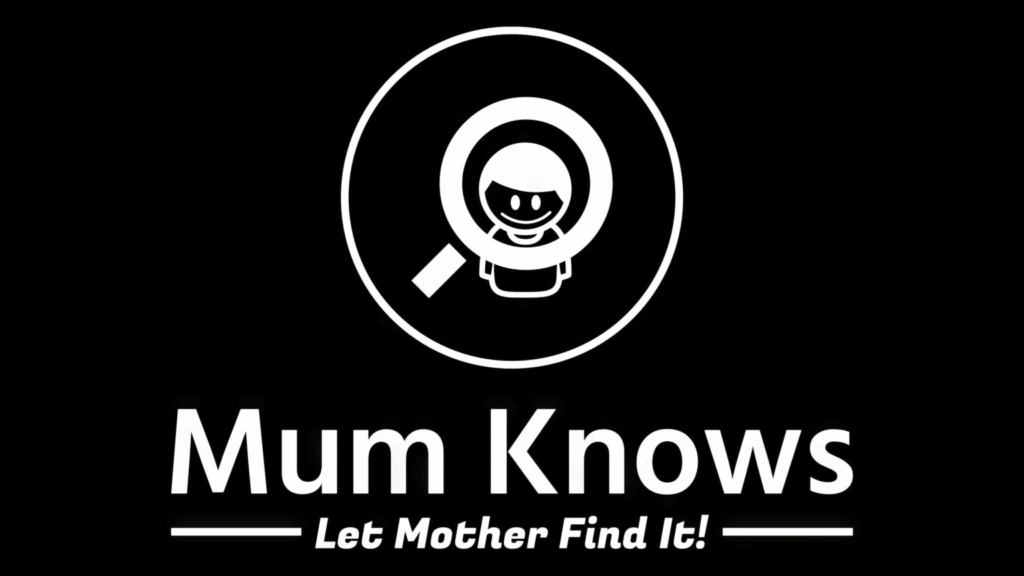
SnipeSearch went live in February 2005, but the project itself began in January 2005 under the internal codename “Mum Knows.” Through 2005–2009 the team iterated under the name “Yahtzee,” adopting a META index approach that blended multiple sources and prioritized lean, operable infrastructure over hyperscale crawling. That foundation—quiet, pragmatic, and cost‑aware—set the stage for subsequent refinements, presenting SnipeSearch as a metasearch engine focused on usefulness and clarity rather than spectacle. From day one, the service concentrated on linking out, aggregating previews, and keeping the experience fast and simple, a posture that matched the realities of a small independent team.
Crucially, this aggregation model kept costs and complexity down in the early days. SnipeSearch didn’t need Google-level infrastructure to crawl and index billions of pages. Instead, it leveraged existing search indexes and feeds, acting as a curated gateway to the web. As the site’s terms explained, SnipeSearch only provides links or brief previews, with full content remaining on third-party sites. This approach let the upstart focus on presentation and user experience without reinventing the entire search wheel.

By 2009, as the project rebranded to SnipeSearch, operating as a tiny independent engine (around 50,000 monthly users) was a David‑vs‑Goliath venture. Google’s market share was soaring, and Microsoft had just rebranded its search to Bing that year. Many observers would have bet against a tiny independent search site surviving long. History seemed to agree – the late 2000s and early 2010s were littered with the ghosts of “Google killers” that failed. For instance, Cuil, a high-profile search startup launched in 2008 with ex-Google engineers, shut down just two years later in September 2010. Blekko, another much-hyped search engine that launched in 2010, managed to last about five years before its technology was absorbed by IBM Watson and the public search service discontinued in 2015. Even venerable names were bowing out: Ask.com, which once challenged Google, gave up on its own search technology in 2010 to pivot to Q&A forums, and Yahoo! shut down AltaVista – a 1990s search pioneer – in 2013.
In this environment, survival itself was an achievement for any independent search engine. SnipeSearch’s ability to weather the storm of competition and obsolescence is noteworthy. As we’ll see, its strategy of staying lean, carving a niche, and continually adapting played a major role in defying the odds.
Building a Comprehensive Search Portal
From the beginning, SnipeSearch aimed to differentiate itself by offering more than a basic web search box. It evolved into a comprehensive portal of search and discovery tools, almost reminiscent of early internet portals like Yahoo!. By the early 2010s, the SnipeSearch site featured a broad menu of content categories and services. Users could perform traditional web searches or switch to specialized verticals like Images, Video, Shopping, and even a Dictionary lookup. The interface also linked to niche resources: an encyclopedia, a recipe search, a book search, and more.
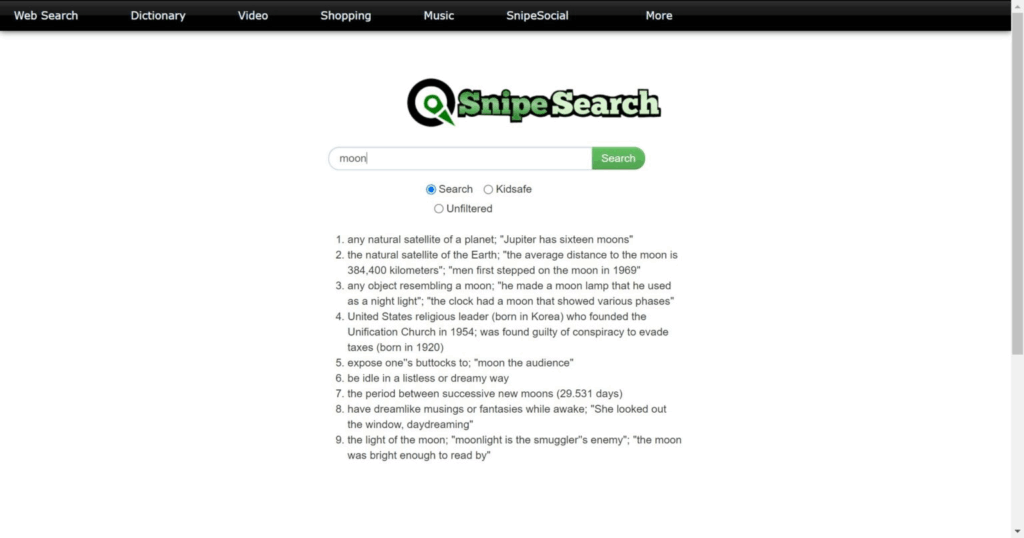
One striking feature was the inclusion of a web directory – a curated listing of websites organized by topic, accessible via a “Directory” link on the site. This harkened back to the pre-Google days of human-edited directories (think DMOZ or early Yahoo Directory), suggesting SnipeSearch’s creators saw value in curated results alongside algorithmic search. The directory listed categories from Business and Finance to Education and Technology, inviting site owners to submit their. While a bit old-fashioned even by 2010, the directory underscored SnipeSearch’s mission to be an “all-in-one” hub for finding information, whether via search algorithms or user-submitted sites.
SnipeSearch’s breadth of offerings extended further. The menu in those years included a “Snipesearch Rank” feature (This was later rebranded as Rommie.net) and even playful extras like a MemeMaker and simple web games under “Play”. These features suggest the site was positioning itself as a community-oriented portal as much as a search engine. It wasn’t just about web results; it was about engaging users with multiple tools and content types under one roof.
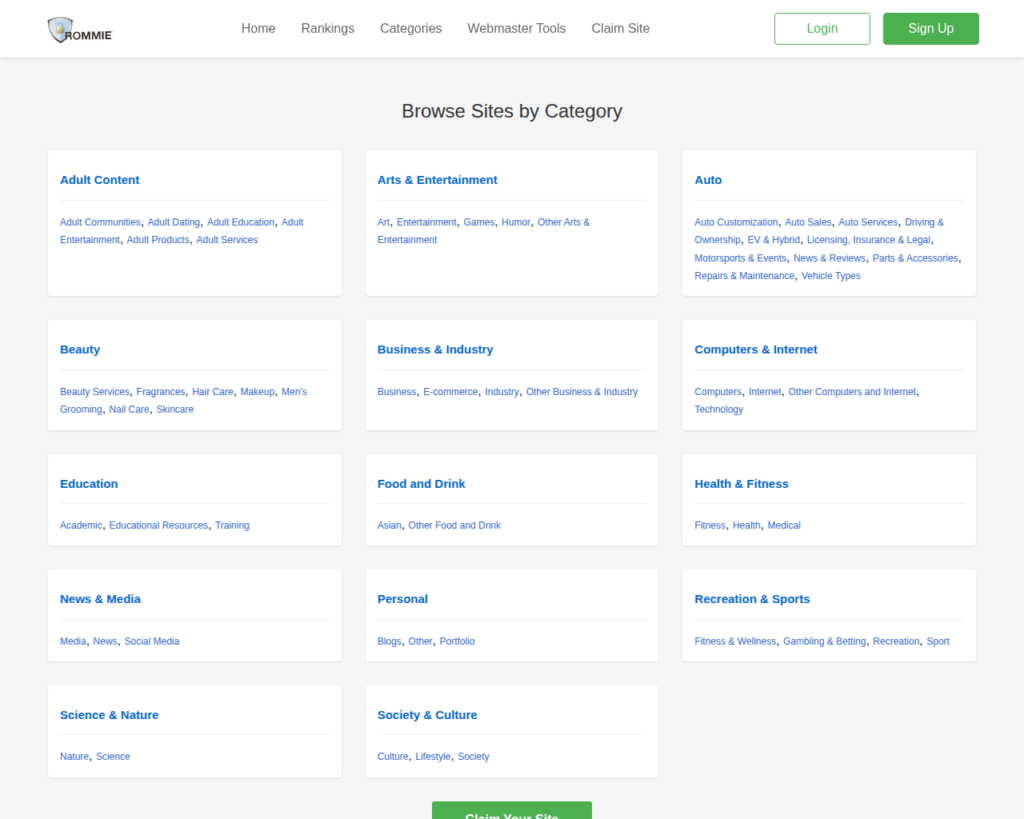
This strategy served a dual purpose: it gave users reasons to stick around (and return regularly), and it set SnipeSearch apart from the minimalist design of Google. Rather than doing one thing exceedingly well (Google’s approach), SnipeSearch did many things on a smaller scale – catering to power users who appreciated an integrated experience. “Don’t just search for it, snipe for it,” the site quipped, as a slogan visible on its pages. The branding implicitly promised a sharper, more targeted search capability, like a snipe or a sniper zeroing in on the target.
Under the hood, SnipeSearch runs a hybrid model. The .net site operates primarily as a metasearch front end, federating partner indexes and curated feeds. The .asia and .info deployments maintain their own crawls alongside YaCy peers, and the core stack includes our own indexer in the Sphider Pro/Plus lineage—rooted in the early Search Engine Studio index from the “Mum Knows” phase. Regionally placed nodes keep latency low and avoid single points of failure; the Phuket YaCy node, for example, sustains a very large corpus on modest hardware. The home experience also broadened over time to surface real‑time headlines and trends, giving SnipeSearch a news‑portal feel alongside search.
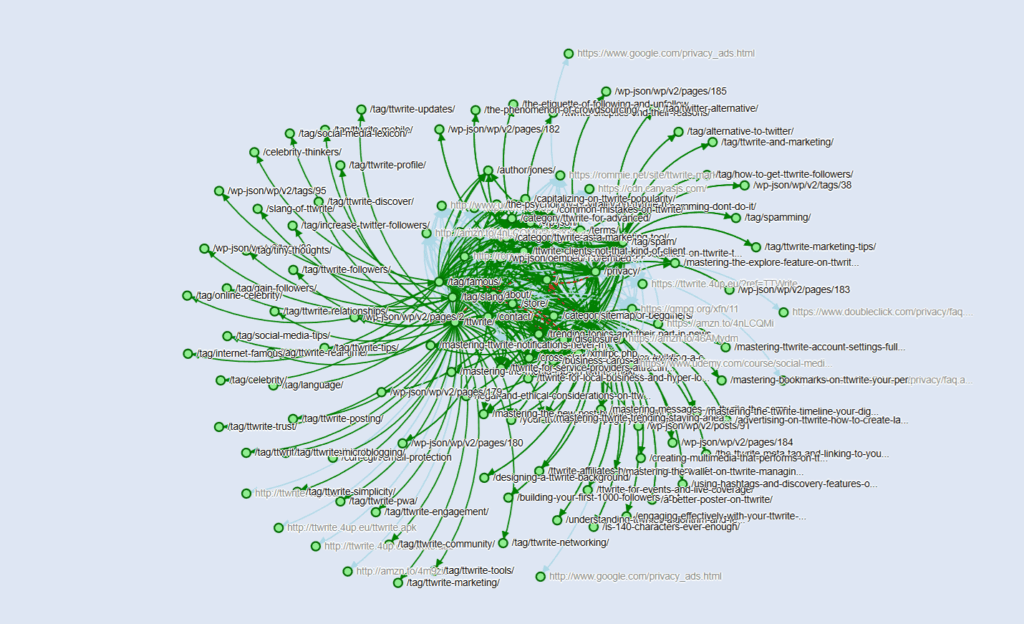
By offering so many avenues to find information – from standard web queries to curated directories and real-time news – SnipeSearch built a small but loyal following of users who preferred its one-stop-shop approach. While never rivaling Google’s scale, SnipeSearch carved out a sustainable niche. It became the kind of homepage that a certain segment of internet users (those craving an alternative experience) would set as their default. In fact, in a December 2009 update, the team proudly announced a code update that made it easier to set SnipeSearch as your homepage “via 1 click,” even suggesting that doing so could help “support children in need when you load your browser!” (This promotion ran for a year, ad revenue was donated from the page loads, the revenue was modest but was about values). It was an early glimpse of the values-driven ethos that would define SnipeSearch’s brand.
“Privacy and Inclusion Above All Else”
SnipeSearch treats privacy and inclusion as engineering requirements rather than slogans, starting with what the index contains and how it is assembled. The crawlers operate on a simple, durable rule: index what is encountered, including subdomains, without first shaping the corpus to a hypothetical user profile. That single choice keeps the widest possible lens on the open web while avoiding the cascade of costs and biases that come with pre‑personalized ingestion. To convert breadth into practical safety, SnipeSearch is integrating Rommie, a site‑risk annotation layer designed to provide clear, consistent cues without suppressing lawful material. Rommie’s role is not to bury pages but to label them: when a domain or path shows known risk signals, a visible status accompanies the result so the user understands what they are about to open. Publishers who want to make those cues verifiable can register for a Rommie badge and surface a Rommie rank, which standardizes trust signals across snippets and previews; the emphasis is transparency for users, not pay‑to‑play access. The effect is an index that remains broad by default, augmented with safety context that is legible, reversible, and easy to audit—privacy preserved because no dossiers are needed, inclusion preserved because categories of content are not quietly excluded.
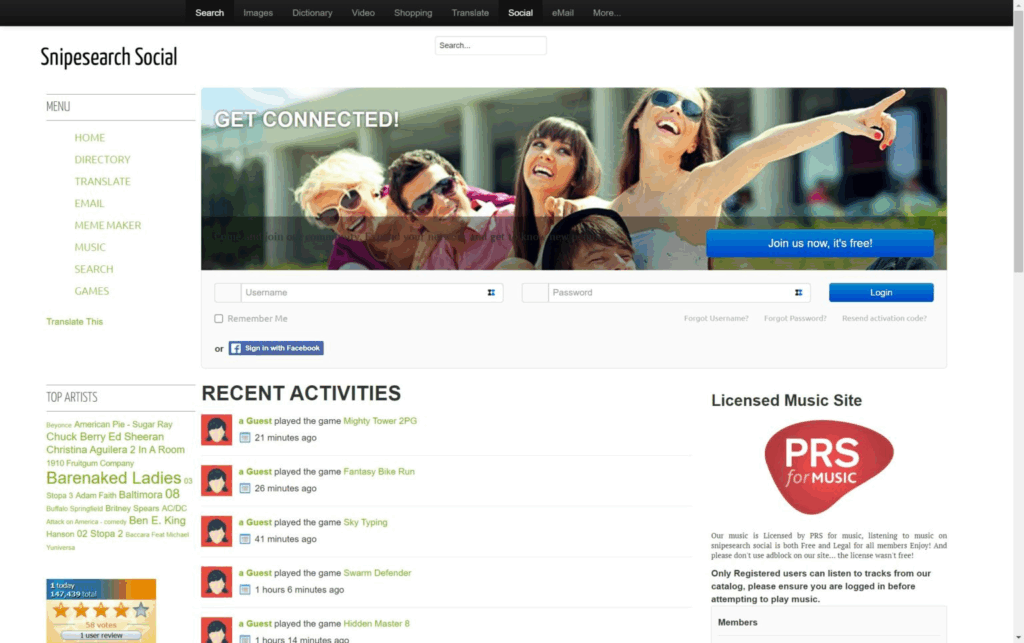
On Snipesocial, inclusion is defined in mechanics, not marketing copy. The timeline is strictly chronological, scoped to the graph a user chooses to follow, with no algorithmic boosting, down‑ranking, or “engagement optimization” that drags people into fights they did not seek. That structure accommodates communities that rarely overlap—from hardcore Republicans to the full LGBTQ spectrum—without forcing proximity through opaque feeds. Content rules are explicit and minimal: adult material is permitted but must be clearly marked; where local law prohibits access, the platform geo‑restricts accordingly. Moderation follows the same human‑first logic. Every report is reviewed by a person who weighs context, community standards, and law; there are no automated takedowns and no AI adjudications determining outcomes. In rare edge cases where a summary could help a moderator understand a language nuance or technical context, a language model may be asked to provide a neutral synopsis, but decision‑making authority remains with a human and, to date, this assistance has not been required. Access mirrors philosophy: the platform provides clients for Windows phones, Android, and Mac, meeting users where they are rather than insisting on a single hardware or app pattern. What users see is what they chose to subscribe to, and what they share is ordered by time—simple, predictable, and fair.
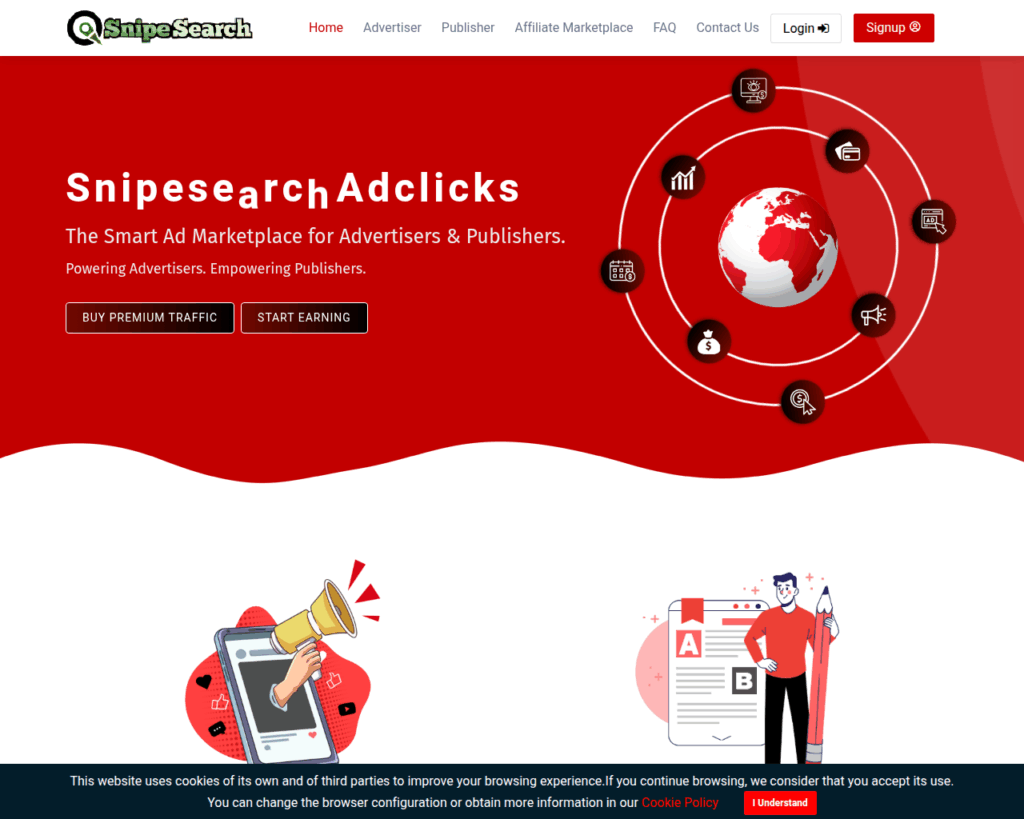
Privacy at SnipeSearch is enforced in the shape of the system before it appears in the text of a policy. The organization minimizes mutable state end‑to‑end: it does not build user profiles for ranking or ads, it avoids unnecessary cookies, and it refuses to warehouse identifiers that do not serve the product. When advertising is not delivered by the first‑party Adclicks network, placements typically come via A‑Ads, a privacy‑centric provider that aligns with low‑state, low‑tracking principles. This posture extends across regions with architectural boundaries that respect law as well as latency. Snipesearch Asia keeps YaCy peers, data stores, and operational control in‑region, both to serve users quickly and to comply with Chinese data laws and neighboring frameworks. Where statutes require it, the Asian index can be made available to local authorities through defined procedures; at the same time, Western data remains in Western regions under Western regimes. Crucially, the Asia deployment offers no user login and does not store IP addresses; the durable artifact is the index itself, not a trail of personal behavior. The result is a network that can answer queries and host conversations without converting people into products, because the machinery that would make that conversion possible simply is not present.

Inclusion on the search side also means resisting quiet distortions of the corpus. Because the crawlers ingest broadly and the ranking pipeline is not tuned to maximize engagement, SnipeSearch avoids a common failure mode of modern platforms: the disappearance of minority or unpopular viewpoints through layers of personalization that claim neutrality while acting as filters. Here, every result competes on its content and context rather than on its advertiser‑friendly profile. Rommie’s labels reinforce that stance by making the safety dimension explicit, not implicit; if a site is trustworthy enough to request verification it carries a standardized rank. That clarity helps researchers, journalists, parents, and casual users in different ways: a reporter can follow a link with informed caution, a parent can steer a child to marked‑safe sources, and a casual user can decide at a glance whether to proceed. Inclusion is thus not only about who gets to speak; it is about who gets to decide for themselves, with enough information at the moment of choice. By aligning the index, the annotations, and the presentation, SnipeSearch preserves the widest practical corpus while giving each user the tools to navigate it responsibly.
Finally, inclusion and privacy together shape incentives that keep SnipeSearch sustainable. A chronological Snipesocial feed means the platform does not chase outrage to juice metrics; a low‑state search architecture means there is no financial pressure to hoard queries for micro‑targeting. That frees product decisions from the gravitational pull of surveillance economics and keeps the door open to audiences who are often alienated elsewhere. Communities that would otherwise splinter under algorithmic pressure can thrive in parallel because the system does not insist on forced adjacency. Advertisers who value intent over identity can still reach audiences through Adclicks without demanding dossiers, and publishers who care about reader trust can participate without surrendering their visitors to a third‑party tracking mesh. Across the stack—from crawlers to badges, from feeds to cookies—the same pattern repeats: build the smallest system that does the job, explain it, and hold the line. That is how SnipeSearch turns a motto into a working model: privacy and inclusion above all else, expressed not as a banner but as code paths, data boundaries, moderator workflows, and clear labels that serve the person at the keyboard first.
Diversification: From Search to Social to Ads
Perhaps the single greatest factor in SnipeSearch’s long survival has been its ability to diversify – to not remain just a search engine. The core search service was the foundation, but the team continually built on top of it, creating an entire ecosystem under the SnipeSearch brand. By expanding into related services like social networking and advertising, SnipeSearch created new streams of users and revenue that reinforced its stability.

The first major expansion was Snipesearch Adclicks, initially search‑only text ads on SnipeSearch results. By late 2009, advertiser onboarding was live on the snipesearch.com domain, and by January 2010 the flow had been refined for campaigns and billing. In 2013, Adclicks moved under the snipesearch.co.uk umbrella as part of a broader rebrand; 2014 saw introduction of publisher features that took Adclicks from search‑only to search + customer sites via embeddable units and an XML feed for syndication. In 2015, Adclicks shifted to its dedicated subdomain adclick.snipesearch.co.uk, consolidating dashboards and APIs.
Across these iterations Adclicks expanded from a basic CPC engine into a full suite: CPC/CPM/CPA bidding, geo‑targeting, keyword and category targeting, image/logo ad support, frequency controls, fraud detection, and real‑time stats. On the publisher side, the program formalized a low $5 payout threshold, and a 20% commission on sponsored clicks, with copy‑paste widgets. Importantly, Adclicks underwrote SnipeSearch without behavioral profiling: ads match intent and page context, not shadow profiles—keeping the core search engine low‑state and compliant while still financing growth. The system offered modern features like geo-targeting of ads and even the ability to include images or logos in ads, with built-in fraud protection to ensure genuine clicks.
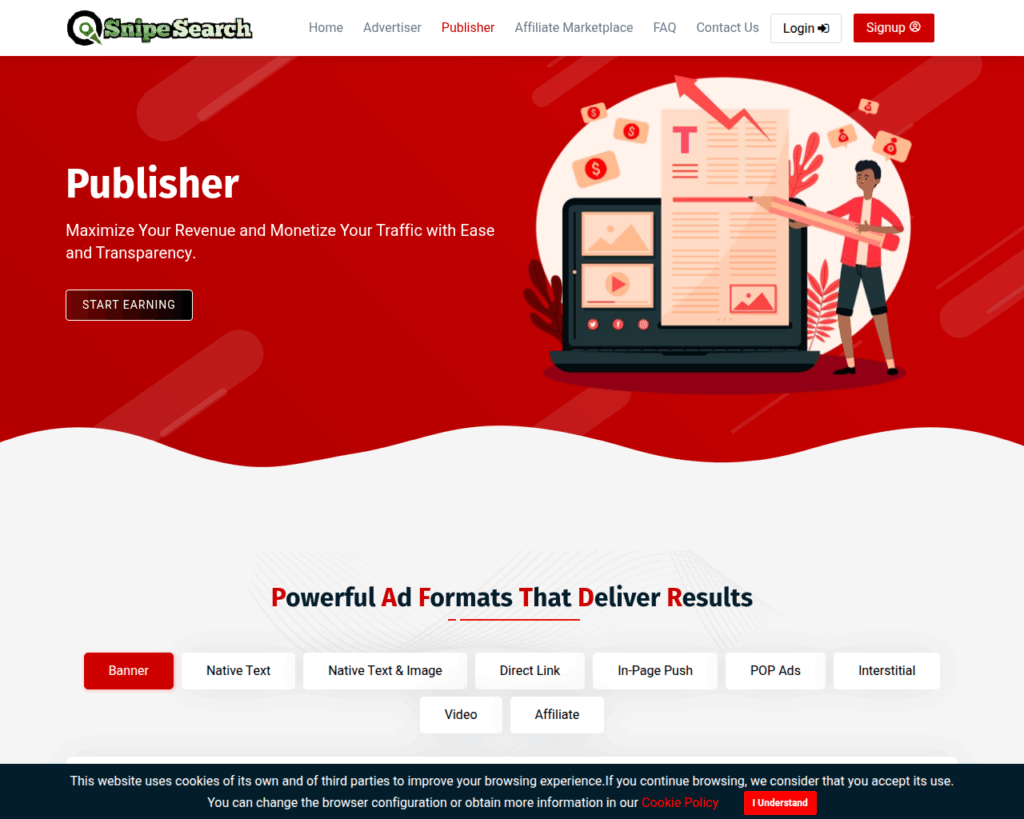
Weekly payouts and real-time stats were offered, making the program attractive to small and medium publishers who wanted an alternative to Google AdSense. Notably, SnipeSearch even provided an XML feed for publishers – meaning other search engines or sites could syndicate SnipeSearch ads, extending the network’s reach.
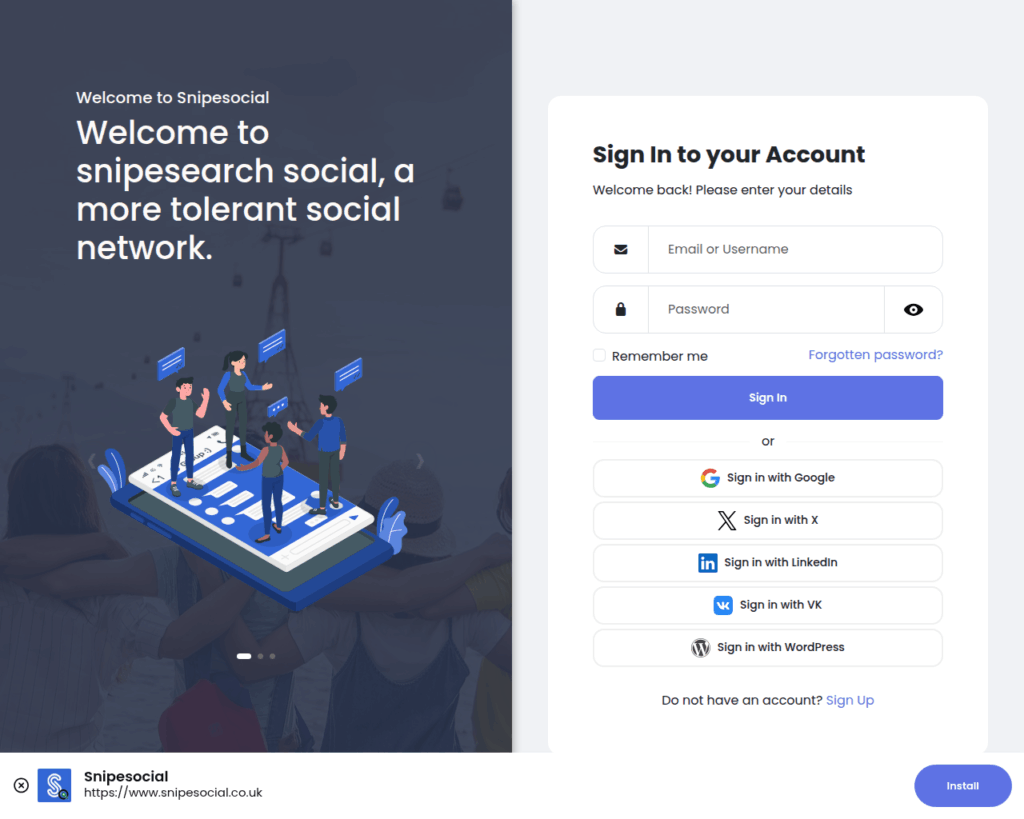
The next expansion was Snipesocial, officially launched on November 13, 2013 and integrated with the main search site. It offers social features without targeting: profiles, posts, groups, pages, messaging, events, long‑form and media, all ordered chronologically with no algorithmic boosts. Engagement on Snipesocial earns points that can be used on‑site or converted to cash, sharing ad revenue with users. The platform also carries full‑length films up to 720p, sponsor‑supported and free to watch. Today the Snipe ecosystem—principally snipesearch.net and Snipesocial —handles ~20 million hits per month, with search and social reinforcing each other while preserving privacy and inclusion.
By building its own advertising ecosystem, SnipeSearch achieved something critical: financial independence. Many search startups fail not because of technology, but because they can’t monetize effectively (Google’s early success was largely due to cracking the code of search advertising). SnipeSearch, recognizing this, effectively created a mini‑ad system of its own. This provided a steady revenue stream to cover operating costs. While there were occasional partner‑funded growth infusions, they were modest—typically no more than about €3,000 in any given year—and the business remained largely self‑sustaining.
Instead of relying on large venture‑capital infusions or a buyout (which often spelled the end for independent platforms), SnipeSearch sustained itself through advertiser and publisher relationships. Every search query on SnipeSearch had the potential to show an Adclicks advertisement, generating a bit of income. Additionally, by opening the network to external publishers, SnipeSearch increased its advertising inventory and brand presence beyond its own site.
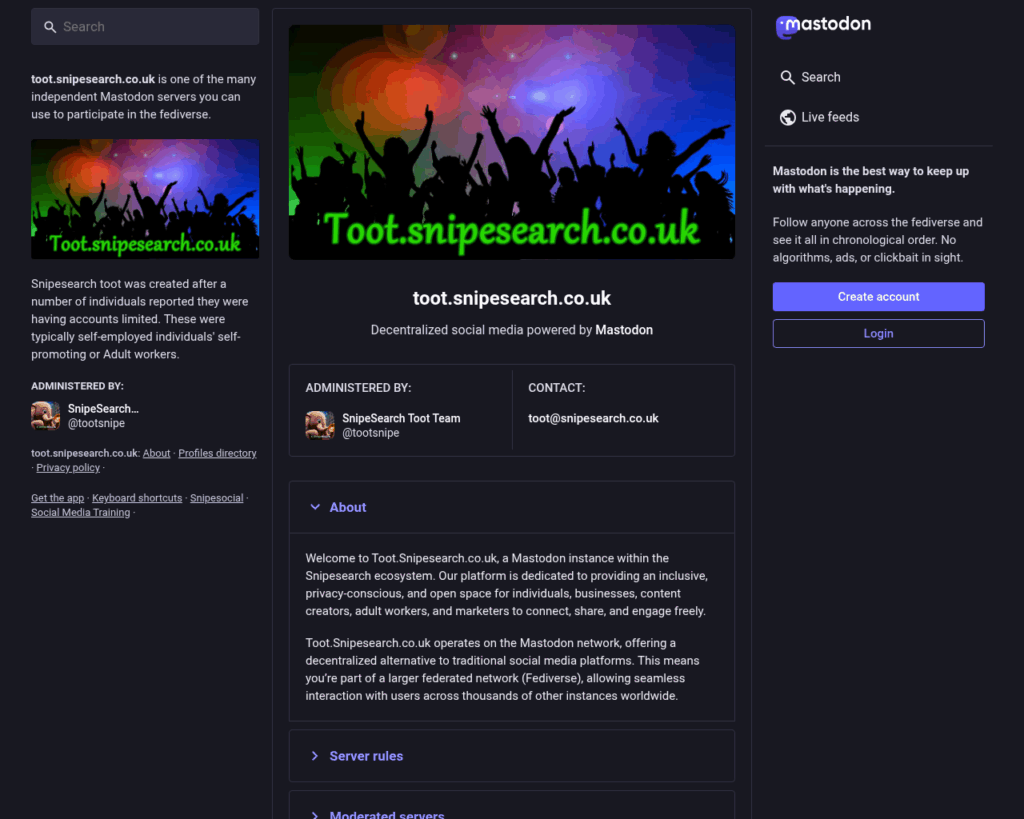
Diversification didn’t stop there. Over the years, SnipeSearch continued to roll out new services aligned with its mission. A few examples:
- Mastodon Instance: As the Mastodon federated social network gained popularity among those seeking decentralized, inclusion-oriented communities, SnipeSearch launched its own Mastodon server (
toot.snipesearch.co.uk). The team signaled its embrace of the latest social technology – again with an emphasis on user-controlled, ad-free experiences that matched SnipeSearch’s ethos. - TTWrite: In 2023, SnipeSearch introduced TTWrite, a microblogging platform, but explicitly “algorithm-free.” Launched on 27 July 2023 as part of the SnipeSearch ecosystem was a response to growing frustrations with mainstream social media. It offered 300-character posts and rich media, but crucially, all posts were shown chronologically with no hidden algorithms promoting or hiding content. “We envisioned a space where a small business owner in Manchester could reach the same audience as a major brand… without fighting against invisible algorithms,” the TTWrite team explained. In other words, TTWrite doubled down on SnipeSearch’s commitment to inclusion and equal footing for users. Within two years, TTWrite had become an authentic and engaging microblogging community. This foray into microblogging shows SnipeSearch’s keen eye for social trends – anticipating the desire for chronological, fair social media feeds at a time when even Twitter (now X) was struggling to please its user base.
Each diversification reinforced SnipeSearch’s core business. The social platforms kept users within the SnipeSearch universe (where they might perform searches or see ads), and the ad network funded development of new features. This multifaceted approach is arguably why SnipeSearch outlasted so many peers: it was never just a one-trick pony at the mercy of Google. Instead, it created its own small ecosystem of interdependent services and a community that sustained them.
Outlasting the Competition
By the mid-2010s, many of SnipeSearch’s contemporaries had vanished or been subsumed into larger companies. Yet SnipeSearch pressed on, marking milestones that few independent search engines ever reach. In 2015, it quietly turned ten years old – a full decade in operation. (For context, that’s longer than the entire lifespan of Altavista or Ask Jeeves as independent entities.) Now in 2025, SnipeSearch celebrates 20 years of continuous service, a rarity in the fast-changing tech world.
What can this longevity be attributed to? Summarizing from the journey we’ve traced, several key factors emerge:
- Founder Persistence and Vision: SnipeSearch has benefited from steady leadership that remained committed to the project’s long-term viability. One of the driving forces is UK entrepreneur Stephen Driver, who has over 25 years of web development experience and has been a public spokesperson for SnipeSearch and Its Dutch co founder Nick Lange who believed in the projects ethos and services and provided much of the sites initial funding and ongoing support. As the contact in press releases and likely one of the founders, Driver’s dedication to SnipeSearch’s mission ensured that the platform never languished. Instead of selling out or shutting down when growth was slow, the team doubled down on serving its niche.
- Community and Niche Focus: SnipeSearch never tried to be “the next Google” for everyone. Instead, it honed in on users who were disillusioned with mainstream tech – whether due to privacy worries, feeling excluded by algorithms, or simply seeking a tighter-knit community. By serving this niche extremely well, SnipeSearch built a base of users who truly cared about its survival. Those users likely spread the word in privacy forums, indie tech circles, and among friends, giving SnipeSearch a slow but steady growth. The fact that SnipeSearch runs multiple regional domains (like snipesearch.co.uk, snipesearch.net, snipesearch.info, and snipesearch.asia) also helped it quietly attract users around the world, from Europe to Asia, without much fanfare. Its inclusive philosophy meant that, for example, international content was welcome – the site even has an “International” section and supports multiple languages in its directory, signaling a global mindsetdirectory.snipesearch.co.uk.
- Financial Sustainability: Unlike many idealistic startups, SnipeSearch paid attention to money. Its Adclicks platform turned the search engine and its network into a revenue-generating machine (albeit a small one compared to Google). By keeping expenses low – running lean servers and not spending lavishly on marketing – and generating income through ads, SnipeSearch stayed in the black. The platform also experimented with creative monetization.
- Continuous Adaptation: Crucially, SnipeSearch did not stagnate. It continually updated its technology and UX to keep pace with changing times. Early on, the team refined the site’s code and SEO. Later, they introduced new interfaces for news and trending content as real-time information became important. They embraced mobile-friendly design as smartphone usage grew.
Staying Human‑Curated in the 2020s
SnipeSearch maintains a no‑AI search posture. The engine does not generate AI summaries, previews, or chat answers on top of other publishers’ content, and it does not ingest user content to train models. This protects creators’ incentives, preserves referral traffic, and keeps ranking rules transparent. Where imagery is concerned, SnipeSearch does not offer image‑generation services and uses creative tools sparingly and ethically. Most imagery across the network is produced by real photographers or by in‑house artwork led by Stephen Driver and Nick Lange; when AI‑assisted workflows are involved (for example, NFTs or stylization), the team uses premium generators that compensate artists, alongside tools like Photoshop and PhotoDirector to transform original photographs.
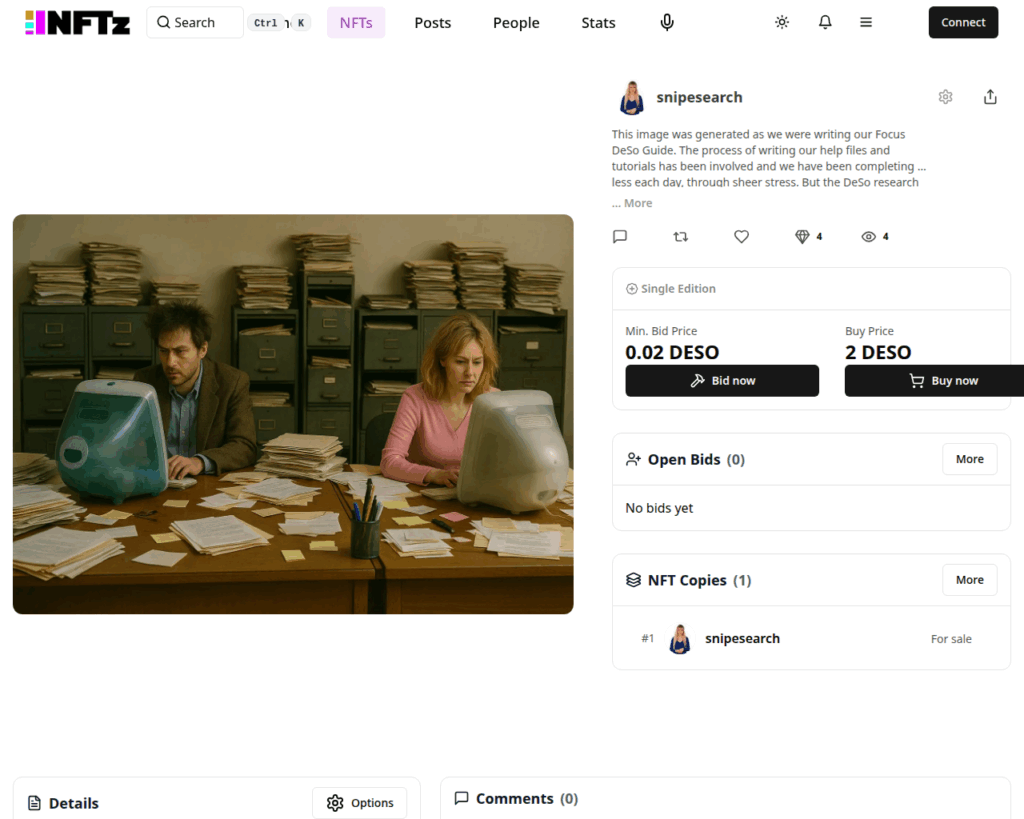
The same restraint applies to copy: the platform favours linking and attribution over paraphrase‑by‑machine, ensuring that the original publisher earns the click and the context remains intact.
On policy, the engine avoids algorithmic sorting that would pre‑shape results; there is no AI preview on searches because that would diminish creators’ ability to earn from their own sites. The commitment is simple and durable: index broadly, rank plainly, attribute clearly, and send users to source pages. Ranking emphasizes query relevance and source clarity rather than predicted engagement, which keeps the experience predictable for users and legible for site owners. Advertising follows the same philosophy: placements are matched to intent and page context, not to behavioral dossiers, and when ads are not delivered by the in‑house Adclicks network the default is privacy‑centric providers such as A‑Ads. Cookies are kept to the minimum needed for stability and security, and session state is not repurposed for profiling. All of this lowers operational overhead while aligning incentives with the health of the open web.
Human curation also extends to governance and accessibility. Editorial choices favour source diversity over homogenized feeds, and presentation steers away from engagement tricks that blur authorship or muddy provenance. When novel tools are evaluated—whether for image processing, indexing assistance, or language help—the bar is ethical use, clear attribution, and explicit compensation where third‑party training data could be implicated. In practice, that means deferring to original creators, crediting photographers and designers, and reserving automation for maintenance tasks that do not touch user expression. The result is a search and social surface that remains people‑first: fast because it is simple, trusted because it is transparent, and sustainable because it refuses the extractive shortcuts that have eroded so much of the modern web.
An Unlikely Survivor and a Model for Sustainability
SnipeSearch’s journey from 2005 to 2025 is a tale of quiet resilience in the face of immense odds. What began as a tiny search engine project has blossomed into a multifaceted platform – encompassing web search, news aggregation, a social network, a microblogging site, and an ad network – all sustained by a loyal community and guided by a steadfast ethos. In a sector where even well-funded companies have come and gone, SnipeSearch managed to outlast and outshine many by staying true to itself and its users.
This longevity can be attributed to a combination of visionary leadership, community-first values, strategic diversification, and technological adaptability. The SnipeSearch team never lost sight of why they existed – to provide a people-centric alternative in a web dominated by big corporations. By emphasizing user privacy and inclusion, they gained trust that money can’t buy. By diversifying into social media and ads, they built buffers against market shifts and created a self-sustaining micro-economy. And by continually improving their technology – whether adding new search verticals in 2010 or migrating its principal index to Sphider Plus in 2013 – they ensured that SnipeSearch was not left behind by progress.
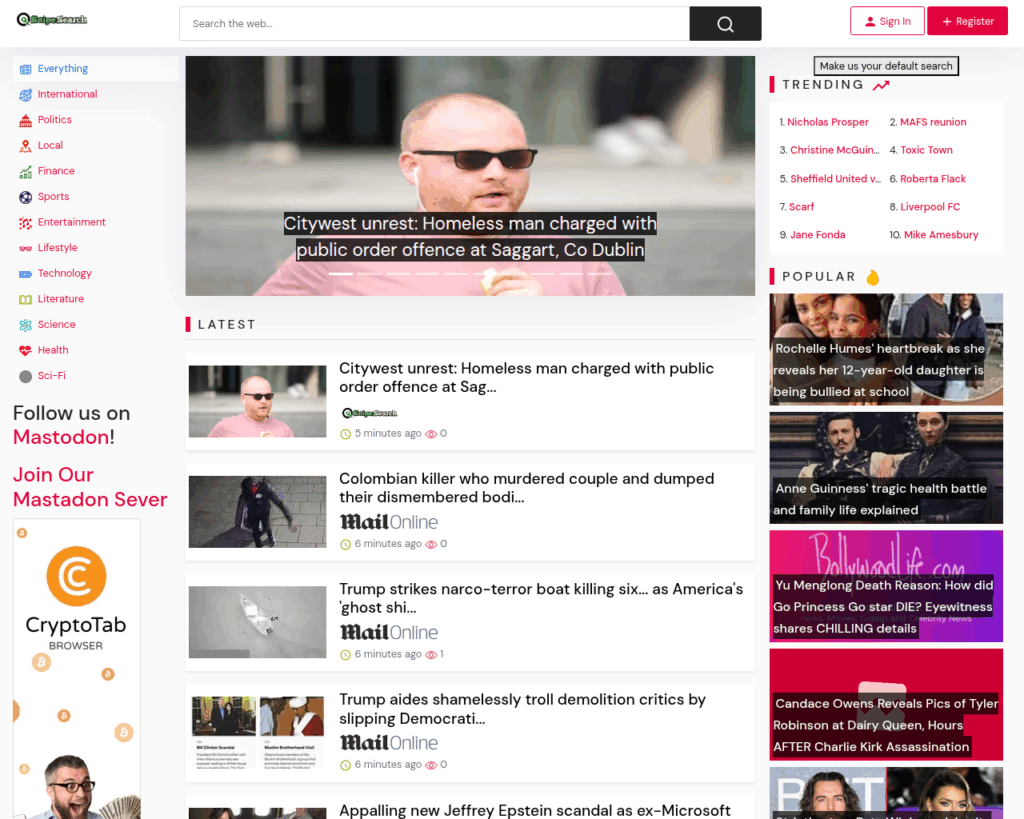
Today, SnipeSearch stands as one of the longest-running independent search engines on the internet. It has weathered the mobile revolution, the rise of social media, the fall of many competitors, and now the pressure to bolt AI previews onto everything—each time choosing creator‑respecting improvements over hype. Its survival is not an accident or mere luck; it’s the result of deliberate, values-driven choices and a relentless commitment to serving a community of users often overlooked by tech giants.
As SnipeSearch runs across its various domains (snipesearch.co.uk, .net, .info, .asia) providing its unique brand of search to users worldwide, it serves as a case study in internet longevity. It proves that even in the shadow of Google, a smaller player can endure and carve out its own space by focusing on what matters to people – trust, transparency, and tailored experiences. In a sense, SnipeSearch’s success is attributed to thinking small to stay big: instead of chasing billions of users, it cultivated thousands of passionate ones; instead of maximizing ad dollars at the cost of user experience, it balanced monetization with user respect.
Looking ahead, SnipeSearch shows no signs of slowing down. If the past is any indicator, SnipeSearch will continue to thrive by staying nimble and listening to its users. In a 2025 press statement, the team behind SnipeSearch’s TTWrite platform summed up their philosophy: “Where every voice matters, every post is seen, and every interaction builds genuine community.” That could easily double as SnipeSearch ’s motto for its entire history.
SnipeSearch’s survival story is a refreshing reminder that the internet’s future isn’t determined only by the monopolies. There is room for independent, community-driven services to not just survive but quietly succeed on their own terms. As SnipeSearch demonstrates, sometimes the best way to compete is not to play by the same rules at all – instead, write your own rulebook, serve your own community, and snipe your way to success one careful step at a time.
Relevant Links
- Support: https://support.snipesearch.co.uk/
- FAQ: https://adclick.snipesearch.co.uk/index.php?page=index/faq
- Contact Form: https://adclick.snipesearch.co.uk/index.php?page=user/support
Stay Connected
- Snipesocial: https://www.snipesocial.co.uk/pages/snipesearch
- Twitter: https://twitter.com/snipesearch_uk
- Facebook: https://facebook.com/snipesearch
- LinkedIn: https://linkedin.com/company/snipesearch/
- VK: https://vk.com/snipesearch_uk
- Focus: https://focus.xyz/snipesearch
- YouTube: https://youtube.com/@snipesearch
- diaspora: https://diaspora.snipesearch.net/people/7431fcf0806c013e936e00163c6e7bdf
- Friendica: https://friendica.world/profile/snipesearch
- Hi5: https://www.hi5.com/snipe5
Analytic Tools
StatCounter: https://statcounter.com/
Rommie Visitor Analytics: https://rommie.net/




